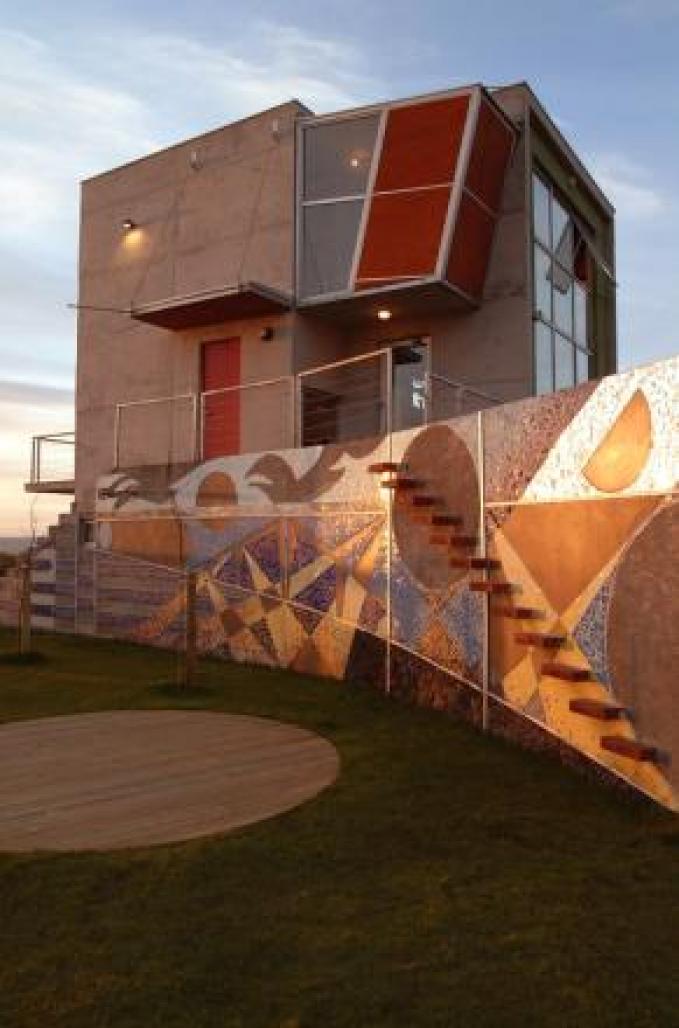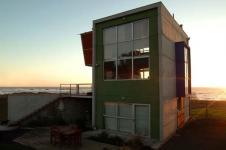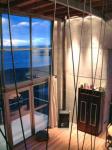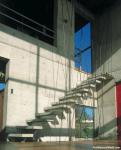Article from Architectural Week
On a beach near an abandoned mine on Chile’s former “coal coast,” the Mauleen House merges historical industrial connections with the raw beauty and energy of the location. Concrete winch towers of the Schwager coal mine dominate the neighborhood’s horizon and influence details of the house design.
With strong winds howling in off the Pacific Ocean and a scorching sun beating down on a strip of black-sand beach, the seafront property is not a “tranquil beach of the summer,” says architect José Miguel Heras, of Factoria Ltda. Indeed, the building lot, land-filled with industrial debris, forced the architect to think in the vertical plane to minimize ground contact.
The coal mining heritage of the location, Coronel in Region VIII, was one of the borrowed references for the design. But the architects, not wanting to replicate the industrial icons, sought a modernist edge for the 1200-square-foot {110-square-meter} house.
“We took certain heights and lines from existing buildings as reference to trace some relationships, but we did not want to imitate the existing architectural typology because it symbolized the past. We wanted to propose architecture of today for this location,” says Heras.
The firm Factoría, which also includes principal Susana Andrea Herrera, attempts to “not leave anything out” when considering project variables of “family nucleus, cultural context, cost, our vision about architecture, and that of the future inhabitants,” according to Heras.
Client Marleen Deblieck and her children Amalia and Violeta were collaborators in the design. Deblieck dreamed of an ample space extending without limits. “I like to be able to look at the horizon and feel that through the sea I am connected with my people,” she says. Her older daughter Amalia contributed, says Heras, “very revealing drawings of her search for her own world.”
Materials and Form
The design considers the multiple project variables without adherence to any particular architectural style, although Heras interpreted the modernist vision of economic and efficient resource use to mean “we do not waste or squander,” enriching the design by incorporating “randomness, fortune, and what cannot be measured.”
Heras explains: “This production form intends to overcome the voids that standardization leaves in terms of taking into account the people, the individual, the ‘other’ that is not included in a given system.”
Casa Mauleen is a three-story, vertically organized cuboid with asymmetrical touches like the windows and garden wall, built with steel-reinforced concrete to reflect the industrial nature of the location and nearby mine winch towers, and to conform to the clients’ budget.
“With little money we must produce work that does not distance itself from good design, good construction, and the minimum comfort that we consider necessary for all humans,” says Heras, adding “good design is not a luxury.”
Factoría used industrial reinforced-concrete shells to add a distinctive wall pattern to the concrete pour in addition to minimizing project costs. “We try to take to the limit the study of how we can use {standard shells}. The house was completely modeled using the {4- by 8-foot {1.22- by 2.44-meter mould}} dimensions,” Heras says.
The multifunctional southern wall curves around a copse of cherry trees to add a softening natural touch. The wall’s south face features a design alluding to “the surrounding marine environment, geologic strata, and the material elements of the mine,” says local sculptor Lautaro Labbé, who created the mural.
This wall also supports staircases to the second floor: its inland end is pierced with steps leading to a breakfast patio, while the seaward end supports a steel and concrete staircase — embedded with blue ceramic tile — leading to the entrance landing adjacent to the breakfast patio.
With the Pacific Ocean to the west and the Andean cordillera to the east, nume
2006








